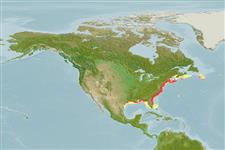>
Eupercaria/misc (Various families in series Eupercaria) >
Sparidae (Porgies)
Etymology: Stenotomus: Greek, stenos = narrow + Greek, stoma = mouth (Ref. 45335).
More on author: Linnaeus.
Environment: milieu / climate zone / depth range / distribution range
นิเวศวิทยา
เกี่ยวกับทะเล,น้ำเค็ม สัตว์น้ำหน้าดิน; สัตว์น้ำที่อาศัยและอพยพภายในทะเลเท่านั้น (Ref. 51243); ระดับความลึก 15 - ? m (Ref. 4926). Subtropical; 46°N - 25°N
Western Atlantic: Nova Scotia in Canada to Florida in USA; rare south of North Carolina, USA.
Length at first maturity / ขนาด / น้ำหนัก / Age
Maturity: Lm 15.5 range ? - ? cm
Max length : 46.0 cm TL เพศผู้/กระเทย; (Ref. 7251); common length : 25.0 cm TL เพศผู้/กระเทย; (Ref. 9988); น้ำหนักสูงสุดที่มีการรายงาน: 2.1 kg (Ref. 40637)
Occurs usually in schools inshore in summer and offshore in winter. Feeds on amphipods, worms, sand dollars and young squid (Ref. 4926). Utilized fresh, smoked and frozen; eaten pan-fried, broiled and baked (Ref. 9988). Exported to Japan (Ref. 9988)
Robins, C.R. and G.C. Ray, 1986. A field guide to Atlantic coast fishes of North America. Houghton Mifflin Company, Boston, U.S.A. 354 p. (Ref. 7251)
IUCN Red List Status (Ref. 130435)
Threat to humans
Reports of ciguatera poisoning (Ref. 30911)
Human uses
การประมง: การค้า; การตกปลาเป็นกีฬา: ใช่; สถานที่แสดงสัตว์และพืชน้ำ: สถานแสดงสัตว์น้ำของรัฐ
เครื่องมือ
Special reports
Download XML
แหล่งที่มาจากอินเตอร์เน็ต
Estimates based on models
Preferred temperature (Ref.
123201): 9.4 - 24.6, mean 23.5 °C (based on 106 cells).
Phylogenetic diversity index (Ref.
82804): PD
50 = 0.7500 [Uniqueness, from 0.5 = low to 2.0 = high].
Bayesian length-weight: a=0.01738 (0.01048 - 0.02881), b=3.01 (2.87 - 3.15), in cm total length, based on LWR estimates for this species & (Sub)family-body (Ref.
93245).
ระดับชั้นอาหาร (Ref.
69278): 3.8 ±0.1 se; based on diet studies.
ความสามารถในการกลับคืนสู่ปกติ (Ref.
120179): ขนาดกลาง, เวลาต่ำสุดที่จะทำให้ประชากรเพิ่มขึ้นเป็น 2 เท่าใช้เวลา 1.4 - 4.4 ปี (K=0.17-0.23; tmax=19).
Fishing Vulnerability (Ref.
59153): Moderate to high vulnerability (51 of 100).
Climate Vulnerability (Ref.
125649): Moderate vulnerability (40 of 100).
Nutrients (Ref.
124155): Calcium = 78.5 [35.6, 139.6] mg/100g; Iron = 1.03 [0.55, 2.10] mg/100g; Protein = 19.3 [18.2, 20.5] %; Omega3 = 0.332 [0.195, 0.556] g/100g; Selenium = 30.7 [14.6, 62.3] μg/100g; VitaminA = 7.68 [2.00, 29.30] μg/100g; Zinc = 0.578 [0.379, 0.855] mg/100g (wet weight);
